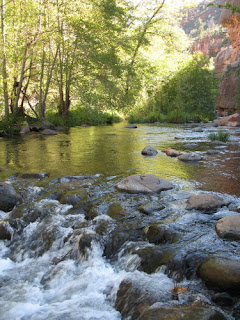Last night, while I was
making pizza to the sounds of Mozart, a warbling song drifted in
through the open windows. In the deep twilight, I couldn’t identify the singer
by sight, but it seemed like the bird was responding to the violins playing on
the stereo. Spring has brought a symphony of birdsong to our backyards and
“neighborwoods,” the local nickname for the Coconino National Forest boundary
that encircles Sedona.
Being so close to national forest, we host a mix of species, shy spotted towhees shuffling beneath bushes
in search of insects, scrub jays scolding loudly from pinons, the occasional
kestral silently watching for rodents or smaller birds from a branch or
telephone pole. A popular neighborwoods walk is to climb Sugarloaf, a red sandstone
butte in West Sedona, where white-throated swifts zoom past hikers’ heads.
Deeper in the forest, the
liquid song of the canyon wren is sweet music to hikers' ears. These small reddish-brown wrens (about five inches
long) hop in and out of rocky crevices and boulder piles in search of insects. The
male’s song is a descending, flutelike tew-tew-tew-tew-tew-tew. Females usually choose nest sites hidden in the
rocks, though one little mother raised her brood inside the room of an ancient
cliff dwelling at Palatki. She tucked her nest in the hole from a roof beam,
and her four offspring grew up under the watchful eyes of the site’s rangers
and hundreds of visitors.
 |
| Cliffs and ledges in Fay Canyon, Sedona |
Rocky canyons like Fay, Boynton, and Long also echo with the piercing cries of hawks and peregrine falcons, a threatened and endangered species (TES). Peregrines nest on
the ledges of Sedona’s famed rock formations—the second highest concentration
of breeding pairs in the state. Where canyons climb to higher elevations, acorn woodpeckers drill holes in ponderosa trunks to store row upon row of acorns, then spend most of their time
relocating and defending their accumulated wealth. (Nature’s metaphor for
modern life, perhaps?)
With nearly two hundred avian
species, from tiny black-chinned hummingbirds to bald eagles, Sedona is a
paradise for birdwatchers. Most birds nest here
during summer, then spend winter months in Mexico or Central and South America.
Seventeen are on the TES list, many of
these—including the Southwestern willow flycatcher and belted
kingfisher—dependent on riparian areas, the lush environments of Oak Creek,
Beaver Creek, or the Verde River.
Some of the
best places for birdwatching near Sedona are Red Rock State Park, the wetlands (reclamation ponds) west of town, or the Page Springs Fish Hatchery. Today is the final day
of the area's top nature-themed event, the Verde Valley Birding and Nature Festival held each April. Whether you're an experienced birder or a beginner hoping to learn a little more about the feathered musicians in your backyard, the "Birdy Verde" is a fabulous event with workshops and guided field trips throughout central and northern Arizona.
Being a naturalist wannabe, I've made an effort over the years to study Sedona's flora and fauna. And yet every spring I find myself needing to relearn birdcalls or distinguishing marks. Binoculars sit by windows, and field guides pile up on shelves and tables along with a notebook and pen. After hearing last night's anonymous warbler, however, I've decided it's okay to remain in appreciative ignorance. Sometimes, not knowing can be sweeter. As psychologist Eric Berne once said,
"The moment a little boy is concerned with which is a jay and which is a sparrow, he can no longer see the birds or hear them sing."
As a writer who travels, I'm often too quick to put a label on the things I see. Sometimes it's better simply to enjoy them.







